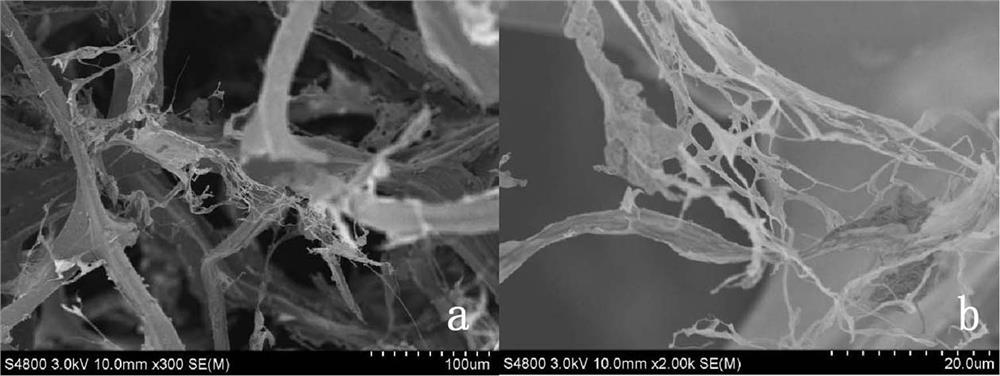A kind of tissue engineered nerve graft and preparation method thereof
A nerve graft and tissue engineering technology, applied in the field of tissue engineered nerve grafts, can solve the problems of lack of biocompatibility, three-dimensional ideal permeable scaffold, difficulty in obtaining neuron cells, etc., so as to avoid gene integration and mutation. Potential safety hazards, promotion of nerve regeneration and functional recovery, minimal trauma
- Summary
- Abstract
- Description
- Claims
- Application Information
AI Technical Summary
Problems solved by technology
Method used
Image
Examples
Embodiment 1
[0044] Preparation of tissue-engineered nerve grafts
[0045] according to figure 1 Schematic diagram of the schematic diagram, first construct the silk protein scaffold, extract the seed cell fibroblasts; then seed the fibroblasts on the silk protein scaffold, expand and culture; finally induce the fibroblasts in the scaffold to transdifferentiate into neurons by small molecule compounds, and The connection between the axons of neurons is established to form a neural network, thereby obtaining a tissue-engineered nerve graft.
[0046] 1) Construction of porous scaffolds of silk protein micro-nanofibers
[0047] After the silk is degummed by boiling at 0.05% (w / v), it is dispersed in 98% formic acid containing 0.1% calcium chloride (w / v) (silk:solution ratio 1:50), and the silk dispersion is placed at -20°C Freeze for 24 hours, then thaw in 75% ethanol for 1 hour, then fully wash with deionized water, and freeze-dry the obtained wet silk protein scaffold to obtain a three-di...
Embodiment 2
[0058] Preparation of tissue-engineered nerve grafts
[0059] according to figure 1 Schematic diagram of the schematic diagram, first construct silk protein scaffolds, extract seed cells human skin fibroblasts; then seed fibroblasts on silk protein scaffolds, expand and culture; finally induce the fibroblasts in the scaffolds to transdifferentiate into neurons by small molecule compounds , and establish the connection between the axons of neurons to form a neural network, thereby obtaining a tissue engineered nerve graft.
[0060] 1) Construction of porous scaffolds of silk protein micro-nanofibers
[0061] After the silk is degummed by boiling at 0.05% (w / v), it is dispersed in 98% formic acid containing 0.1% calcium chloride (w / v) (silk:solution ratio 1:50), and the silk dispersion is placed at -20°C Freeze for 24 hours, then thaw in 75% ethanol for 1 hour, then fully wash with deionized water, and freeze-dry the obtained wet silk protein scaffold to obtain a three-dimensi...
Embodiment 3
[0069] Transplantation of tissue-engineered neural grafts in the treatment of spinal cord injuries
[0070] 1) Establishment of spinal cord transection model
[0071] The rat spinal cord transection model was constructed, and the spinal cord tissue with a length of 2 mm at the T10 level was excised.
[0072] 2) Transplant tissue engineered neural grafts
[0073] Filling the spinal cord defect with tissue engineered nerve grafts, such as Figure 7 shown.
[0074] 3) Behavioral observation and scoring
[0075] Put the animal into an open pot, tap the pot wall to make it crawl, and observe the animal's buttocks, knees, ankles, trunk movement and coordination.
[0076] Such as Figure 8 with 9 As shown, it can be seen from the BBB score that all mice were completely paralyzed 1 day after the operation, indicating that the modeling was successful. After stent implantation, the BBB score increased gradually, and there were significant differences among the groups within 1 wee...
PUM
| Property | Measurement | Unit |
|---|---|---|
| diameter | aaaaa | aaaaa |
Abstract
Description
Claims
Application Information
 Login to View More
Login to View More - R&D
- Intellectual Property
- Life Sciences
- Materials
- Tech Scout
- Unparalleled Data Quality
- Higher Quality Content
- 60% Fewer Hallucinations
Browse by: Latest US Patents, China's latest patents, Technical Efficacy Thesaurus, Application Domain, Technology Topic, Popular Technical Reports.
© 2025 PatSnap. All rights reserved.Legal|Privacy policy|Modern Slavery Act Transparency Statement|Sitemap|About US| Contact US: help@patsnap.com



